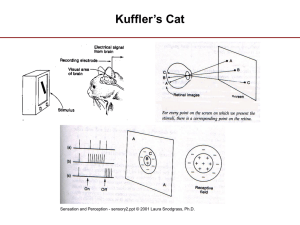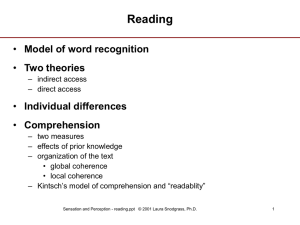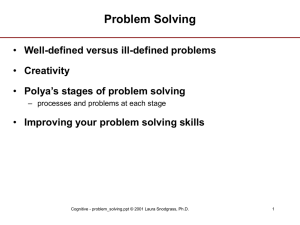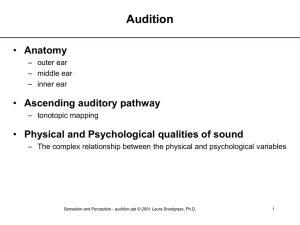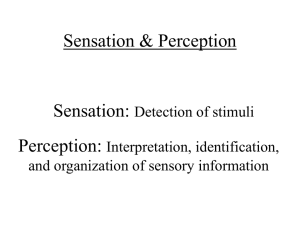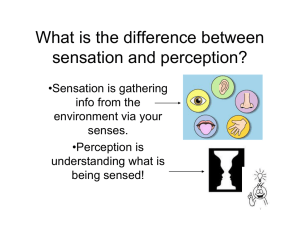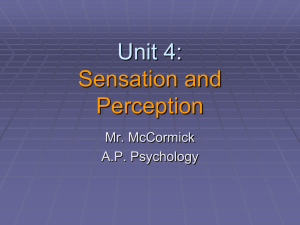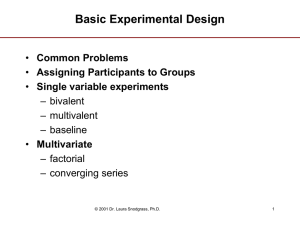Depth Perception
advertisement
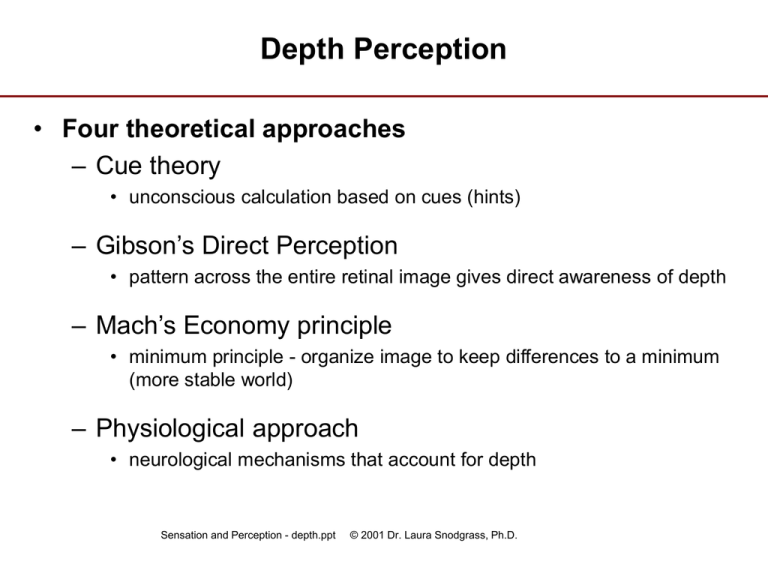
Depth Perception • Four theoretical approaches – Cue theory • unconscious calculation based on cues (hints) – Gibson’s Direct Perception • pattern across the entire retinal image gives direct awareness of depth – Mach’s Economy principle • minimum principle - organize image to keep differences to a minimum (more stable world) – Physiological approach • neurological mechanisms that account for depth Sensation and Perception - depth.ppt © 2001 Dr. Laura Snodgrass, Ph.D. Sources Of Information About Depth • Monocular or pictorial cues – Information processed with one eye or presented in a picture • Kinetic cues – Changes in the retinal image as you move in the environment. – Pattern of changes depends on distance from the observer • Binocular cues – Normally requiring two eyes Sensation and Perception - depth.ppt © 2001 Dr. Laura Snodgrass, Ph.D. Monocular (Pictorial) Cues • Size – relative size - smaller is farther – familiar size • Linear Perspective – convergence of parallel lines (train tracks) • Interposition (occlusion) – closer object cuts off part of view of further • Aerial Perspective – haze and blueness Sensation and Perception - depth.ppt © 2001 Dr. Laura Snodgrass, Ph.D. Monocular (Pictorial) Cues • Relative brightness – brighter is closer • Shade and shadow – convex - shadow below – concave shadow on top • Texture density gradients Sensation and Perception - depth.ppt © 2001 Dr. Laura Snodgrass, Ph.D. Kinetic Cues • Transformation of the retinal image resulting from movement of the head or body • Motion Parallax – near points move in direction opposite of self – far points move in same direction • Motion Gradient – near objects are displaced faster than far – moon follows you • Optical Expansion pattern – as get closer image expands on retina – as get further image constricts Sensation and Perception - depth.ppt © 2001 Dr. Laura Snodgrass, Ph.D. Binocular Cues • Monocular and Kinetic cues provide only relative distance information • Binocular cues provide absolute distance • Accommodation – change in shape of lens for distance up to 20ft. • Convergence – triangulation up to 20ft. • Stereopsis Sensation and Perception - depth.ppt © 2001 Dr. Laura Snodgrass, Ph.D. Stereopsis • Retinal disparity – each eye gets a slightly different view of the world • Matching up the images in the two eyes – at the optic chiasm the crossing of the optic fibers from the nasal hemiretinas results in the lefts sides of each eye being matched up and the right sides of each eye being matched up Sensation and Perception - depth.ppt © 2001 Dr. Laura Snodgrass, Ph.D. Horopter Sensation and Perception - depth.ppt © 2001 Dr. Laura Snodgrass, Ph.D. Corresponding Points Sensation and Perception - depth.ppt © 2001 Dr. Laura Snodgrass, Ph.D. Corresponding Points • Objects that fall on the same point on each eye fall on corresponding points • Anything that falls on the horopter will fall on corresponding points • Area 17 in occipital lobe - corresponding point detectors – single cells that respond only when corresponding • Single clear image of which you are consciously aware Sensation and Perception - depth.ppt © 2001 Dr. Laura Snodgrass, Ph.D. Disparate Points Sensation and Perception - depth.ppt © 2001 Dr. Laura Snodgrass, Ph.D. Disparate Points • Objects that are closer or further than the horopter fall on different places in each eye – disparate points • Area 18 in occipital lobe - disparity detectors – single cells that respond to specific degrees of disparity – basis for depth perception • Double images that are not consciously perceived Sensation and Perception - depth.ppt © 2001 Dr. Laura Snodgrass, Ph.D. Retinal Fusion • Combining the two retinal images • Panum’s fusional area – not point to point correspondence, small area to small area • False fusion – incorrect matching of images from the two eyes – basis for “magic eye” pictures Sensation and Perception - depth.ppt © 2001 Dr. Laura Snodgrass, Ph.D. Fusion of Dichoptic Images • Dichoptic – different image in each eye • Three possible outcomes – summation – suppression – rivalry Sensation and Perception - depth.ppt © 2001 Dr. Laura Snodgrass, Ph.D. Fusion of Dichoptic Images • Panum’s limiting case – most simple example to illustrate the problem of combining different images • Fechner’s paradox – when both eyes are open is the room brighter than with only one eye? – does the brightness in each eye add together? Sensation and Perception - depth.ppt © 2001 Dr. Laura Snodgrass, Ph.D. Panum’s Four Rules of Dichoptic Viewing • Rivalry of contours at intersections • Mosaic combination when no contours overlap • Dominance of contours • Binocular mix of colors – under what conditions do the colors add? – Under what conditions are the colors rivalrous? Sensation and Perception - depth.ppt © 2001 Dr. Laura Snodgrass, Ph.D. Random Dot Stereograms • What if contours are NOT the basis for matching the retinal images? • brain can match up “brightness blobs” Sensation and Perception - depth.ppt © 2001 Dr. Laura Snodgrass, Ph.D.
